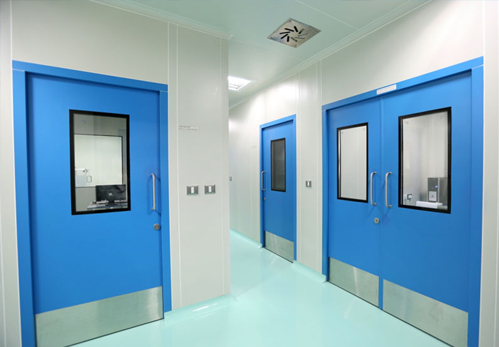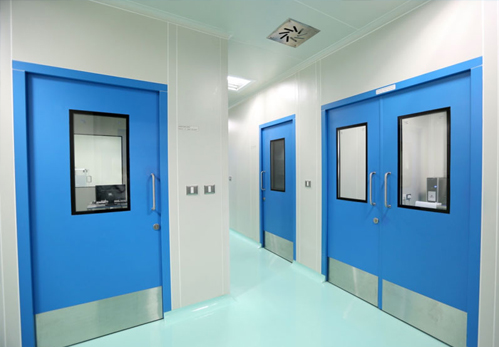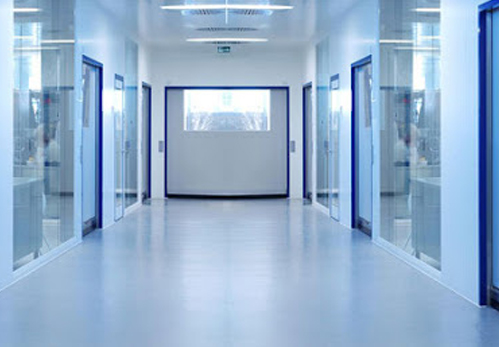Medical Devicess Cleanrooms are clean air environments where a specific size of air particulates is prevented from entering. Cleanrooms keep air pollutants controlled during manufacturing and operations in industries like E-liquids, science and technology, healthcare, as well as food production.
SAerosol particles, bacteria, pathogens, chemical vapours, fibrous materials and more are types of pollutants that can hurt the manufacturing process in these industries. Our Medical Devicess Modular Cleanrooms are developed to meet the required standard of the international organisation for standardisation (ISO) 14644-1: 2015.
The ISO 14644-1:2015 compliant Medical Devicess Modular Cleanrooms vary between class 1 and 9. The classification of each Cleanroom changes dependent on size and prevalence of the air particulates in the cleanroom. The Class 1 classification is the greatest in the range and it is tested for the lowest frequency and smallest particulate size while the Class 9 classification represents the least in the range and is valued based on a higher frequency and larger air pollutants present in the cleanroom at any given time.

Particle counters are employed as the test method for classifying Medical Devicess Modular Cleanrooms. This method measures the size and quantity of particles using the Particles Per Cubic Metre (PPCMM) unit. The Particles Per Cubic Metre of an (ISO) 14644-1: 2015 Class 9 Modular Cleanroom corresponds to normal atmospheric air with contaminants >5 microns not allowed into the environment.
A Class 1 Cleanroom will be designed to filter out much smaller air pollutants >0.2 and >0.1 which makes it the cleanest air enclosure in the classification range. An example of this testing requirement is as follows.
To be classified as a Class 7 Cleanroom, a clean air environment must have a particulate count of not more than 352,000 with a particulate size of >0.5. Modifications will have to be put in place if the Medical Devicess Cleanroom does not meet the requirements for this classification.
Pollution-Free Production
The amount and sizes of air particulates maintained in Medical Devicess Modular Cleanrooms are achieved through the use of HEPA/ULPA filtering technology. This method is scientifically proven to filter out different sizes and amount of pollutants in the air entering the cleanroom. Non-filtered air passes through Filter Fan Units (FFUs) creating a positive pressure area inside the cleanroom. Contamination is controlled in the clean air environment by means of the positive pressure as it prevents non-filtered air from flowing back into the cleanroom through exhaust openings.
With the above-mentioned cleanroom, contamination-free manufacturing is allowed to take place as air that hasn’t gone through the filtration unit will be prevented from entering the clean air space.

Modular Cleanroom Benefits
- Modular Construction
- Quick Assembly Time
- Versatility
- Reconfiguration
- Airflow Control
- Inexpensive Modifications
The Medical Devicess Cleanroom technology significantly decreases the chances of product pollution and is the first step in developing a clean air area for production. The second steps that should be taken in mitigating contamination are measures that will avoid cleanroom personnel from bringing in pollutants. This introduction of contaminants can be prevented by the proper use of Cleanroom PPE such as gowning, hair nets and overshoes. This will reduce fibres and potential contaminants from entering the Medical Devicess Cleanroom and interfering with Production/ research. Operators of Medical Devicess Cleanrooms must be adequately trained on contamination reduction processes to keep the Cleanroom safe from contamination.
Cleanroom Design, Build & Validation
- Budgeting and planning
- Engineering, design & layout
- Airflow and filtration design
- Construction and Installation
- Full Certification of our product
- Industry-specific equipment installation
- Validation
Pharmaceuticals Industry And Saakvee

At saakvee, we build Medical Devicess Modular Cleanrooms of the highest standard by employing our experience of over thirty years and our expert engineers. The Medical Devicess Modular Cleanrooms we provide have a remarkable history of reliability and durability. Every project delivered by us at Saakvee goes through strict supervision from planning to validation in order to ensure our customers are satisfied. Our cleanroom solutions are one of the most competitive due to the fact that we oversee our design and installation processes.
From Ultra-bright LED panelling to Engineering Grade aluminium, Saakvee derives a sense of accomplishment in providing the most sophisticated technology to help you increase productivity. We are so confident in our ability to provide a long lasting and quality product that all of our Medical Devicess Modular Cleanrooms receive a five-year warranty.
Industry Requirements
The use of a Cleanroom is crucial for any industry that requires their processes to have a reduced particulate occurrence to avoid the microbial spoiling and/or contamination of goods.
The Cleanroom is crucial for reducing particulates in the production environment via air filtration. The use of Cleanrooms are employed in industries such as science and technology, semiconductors, production, electronics, medical devices, research, food production and more.

At Saakvee, our main goal is to see to it that you’re provided with the right solution for your needs. You can be guided by our experts if you’re entirely sure of the standard of Medical Devicess Cleanroom your industry requires.
We only provide Medical Devicess Modular Cleanrooms that meet the ISO 14644-1: 2015 standard. These ISO 14644-1:2015 compliant Cleanrooms vary in classification between ISO 1 and 9. A Cleanroom will be classified based on the prevalence and size of the air particulate in the clean air space. Tests for the smallest sizes of particulates will be carried out for the highest classification (class 1) while class 9, which is the least classification, has a requirement for a higher prevalence and larger size of contaminants present in the clean air environment.
The use of particle counters is adopted to test Medical Devicess Modular Cleanrooms for categorisation, where the enclosed space is measured by Particles Per Cubic Metre (PPCM). Particle counters measure air particulates by quantity and size. More cleaner air environments are realised with ISO 1 cleanrooms because they focus on the removal of the smallest air particulate sizes >0.1 microns and >0.2 microns while ISO 9 Medical Devicess Modular Cleanrooms are only dedicated to the elimination of larger air particulates >5 microns.
Modular Cleanroom Services
- Design & Build
- Free Site Survey
- Free Design Service
- Cleanroom Planning
- Construction and Installation
- CNC Engineered
- Training & Support
- Discounted Service Contracts
- Remedial Works
- Panel Repairs
- Alternations
- BMS Management
- Cleanroom Certification
- Differential Pressure Qualification
- Servicing Testing Validation
- Smoke Testing
- DOP Testing
Containment Solutions

Containment technologies are needed in cases where there are dangerous substances emanating from the cleanroom that require removal from the air exiting the production area into the external environment. This can be achieved in a Modular Cleanroom with the capability to protect production processes by letting in filtered air and prevent dangerous materials from leaving through the use of carbon filters, ULPA (Ultra-Low Particulate Air), or HEPA (High-Efficiency Particulate Air). At Saakvee, we can provide the solution to your containment needs preventing the exposure of hazardous chemicals to the outside atmosphere with the aim to help you become ever more compliant with your regulators.
Each containment solution we provide is unique as not two hazardous materials are the same and vary on quantities dependent on the use. This entails the need for custom made containment systems for every customer. We will always work closely with you to provide a system that ideally suits your needs.
Airflow And Filtration
Our Cleanrooms are designed to be compliant to the specified ISO 14644-1:2015 grading. With this in mind, we take into consideration the level of air filtration required and the end function of the cleanroom. The level of air filtration required is determined by the air changes per hour (ACH), this determines how many Filter Fan Units are to be used in the cleanroom. What we also determine by the strategic positioning of the FFUs and exhausts is the flow of air around the cleanroom. This can mean the difference between a uni-directional (laminar flow) and a non-unidirectional (turbulent flow) airflow around a cleanroom, potentially leading to a contaminated product. With this in mind, we can greatly increase the number of ACH and control the air flow within the cleanroom.
Filtration of air is controlled by our ultra-quiet, high-efficiency filtration modules. These filtration modules automatically compensate for a build-up of dust and other materials that occur over time within a HEPA/ULPA filter increasing the fan speed to reach the set flow rate. This increases the life of the filter, reducing cost overtime for the end user.
Cleanroom Features
- GMP
- ISO 4-9
- ISO 14644
- Low Power Consumption
- Environmentally Friendly
- HEPA Filters
- Air Filtration
- Fan Filter Units
- Cleanroom Ceiling System
- Temperature Control
- Access Control
- Inter Lock Door Systems
- Air Showers
- Unidirectional Airflow
- Desiccator Cabinets
- Horizontal Flow Wall Modules
- Horizontal Laminar Flow Clean Benches
- Laminar flow cabinets
- Laminar Flow Canopy
Cleanrooms Customised To Your Needs
At Saakvee there is no such thing as a standard modular cleanroom. Each Cleanroom we design is made to fit your unique work conditions and is designed with your needs in mind. We make each modular Cleanroom to order and make you part of the design process.
With Saakvee you have the option of doing almost anything with a cleanroom design. This means that your Cleanroom can be many shapes and sizes fitting the most obscure of rooms and can have a range of finishes. We have yet to find a design that we could not accommodate.

Our customisable options mean that all components of the Cleanroom such as doors, windows, lighting, ceilings and filtrations can be altered to better suit your needs. You also have the option of installing furniture, air showers, pass through chambers, fire suppression, air-conditioning and much, much more. We pride ourselves in being able to meet design requests however unique in shape and size they may be.
